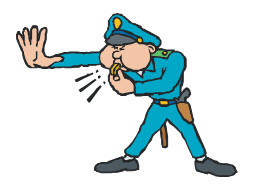9 July 2014
It's a simple concept: Citations, like a lot of professions, have distinctive "uniforms." So dress 'em right!
The police wear uniforms that identify them as law enforcement. Doctors and nurses wear uniforms that identify them as medical personnel. If we need a police officer, we don't look for somebody in a scrub suit, do we?
 Citations are also 'dressed' certain ways to identify what they are: a manuscript, a book, a journal article, etc.
Citations are also 'dressed' certain ways to identify what they are: a manuscript, a book, a journal article, etc.
Some parts of a citation wear fancy clothes: italics are used for titles of published works like books and standalone maps; that tells everyone the work is published. Some parts of a citation wear jewelry: "earrings", for example, when used around a title, says we're citing either an unpublished manuscript or the title of an article or chapter that appears in a larger publication—and the title of that larger work, of course, would be italicized to tell us that it's the larger publication.
So what does all this matter?
For starters:
- To locate a cited manuscript journal article, we don't look for it in the same catalogs that we use when looking for books.
- When we need a book, we don't look for it in NUCMC, the National Union Catalog of Manuscript Collections.
- When we need a journal article, we don't look for it in PERSI (the PERiodical Source Index).
- When we need a manuscript, we don't look for it in the catalog of copyrighted publications at the Library of Congress.
As researchers, it's tempting to roll our eyeballs at what seems to be endless rules for citing the sources that give us all our goodies. Rules. Schmules. Who cares? ! Truth is, all these "rules" that have become common practice exist because they help us with our work. Like police officers, doctors, and nurses, they're our friends—and learning to spot their uniforms really is simple stuff.